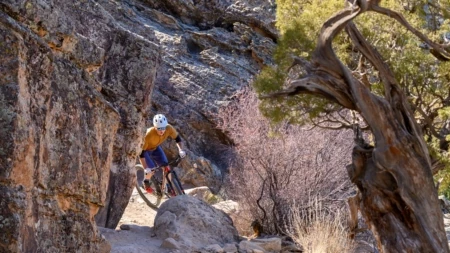Vince Anderson Q&A
When Vince Anderson took a break from alpine climbing, his mountaineering attitude manifested itself in a single-speed hardtail, on which he’s won some of the sport’s most grueling races.
Vince Anderson is an accomplished guy. Since he became one of the first Americans to earn the coveted IFMGA certification—the highest level for rock, alpine and ski guiding—the longtime Patagonia alpine ambassador has led countless skiing and climbing trips around the world. In 2005, Vince and fellow Patagonia ambassador Steve House gained international prominence for their ascent of Nanga Parbat’s Rupal Face, the first of many cutting-edge first ascents in the Himalaya and Canada. Then in the late 2000s, just as he was becoming one of the best high-altitude, technical climbers in the sport, Vince quietly stepped away from the hardcore alpine climbing world.
That’s when he met the woman he would eventually marry, a mountain biker named Colleen Craig living in Grand Junction, Colorado. Vince moved to the rough-around-the-edges desert town shortly after, and though he was still making his living as a guide and a guide instructor, mountain biking and raising a brood of boys—13-year-old Chente, 8-year-old Maxon and 6-year-old Travis—became his new focus.
Unlike nearby Fruita, Grand Junction’s trails are rocky and highly technical, a place where most locals ride aggressive, full-suspension bikes and where unlocking a line requires persistence, practice and a little bit of luck—the same qualities needed to climb the world’s highest mountains. Vince’s all-or-nothing mountaineering attitude manifested itself in his bike choice: a single-speed hardtail, on which he’s either won or podiumed at a number of infamously grueling races.
There are few climbers and mountain bikers who do more than dabble in both sports; there are just a handful who do both at a professional level. Vince is one of those rare souls who can speak firsthand to the similarities and differences between two disciplines that demand so much sweat, dedication and—in some cases—broken bones.
When and how did you start mountain biking?
I have been riding a bike for most of my life. Growing up in Golden, Colorado, I watched the Coors Classic road race and rode my bike on the gravel roads in the mountains around my grandparents’ house. I got my first mountain bike in 1986, but I began climbing and mountaineering when I started college in Boulder, Colorado, so biking took a back seat.
I still had a bike when I lived in Ridgway, Colorado, in the early 2000s, and would do a ride or two a year. Then I read an article on making a single-speed and how [single-speeding] was a great workout, so I converted my old, crappy bike into a single-speed for training. Eventually, I realized it was different and I enjoyed the challenge, so in 2008 I went down the rabbit hole and got a modern single-speed.
What got you started racing mountain bikes?
I was still climbing at the time but wanted to mellow out a bit. Colleen asked me if I had ever raced; I’d run cross country as a kid, but I’d never raced on a bike and decided I’d try it out.
I entered the 2009 Breck Epic, a six-day backcountry stage race. The rules stated competitors should have some racing experience—which I didn’t—but there was a joke going around that the race director would consider making an exception for anyone who’d summited Everest without oxygen. I figured that while I hadn’t done that, I’d done other stuff in that league. So, I emailed the director.
That race suited me well. A lot of shorter races are fast, furious and intense. Because the Breck Epic is longer, it took away some of that intensity. I’d already been riding my bike for cardio to prepare for week-long expedition climbs and was OK with some level of discomfort for a tangible goal. But I didn’t know what I was getting into.
I’ve raced the Breck Epic a total of nine times now. I finished midpack that first year. The next year, I went all in and trained. I missed the Breck Epic [that year] because I had a guiding job in Europe, so instead I rode the Breckenridge 100—a 100-mile endurance race that climbs some 13,700 vertical feet. I ended up on the podium, which was cool.
What aspects of mountaineering crossed over to help you on the bike?
How to prepare physically for a goal and basic training principles. I knew how to train from climbing, and my strengths really suited longer mountain bike rides and races.
Mountaineering is quite different from high-end rock climbing, in that it requires greater mental capabilities. You need a willingness to endure discomfort or things that aren’t fun for the hopeful chance at success. Bike racing also rewards that mental fortitude; it’s about how close to that barrier you’re willing to let your body get before you just give up. I think I gained that from mountaineering.
How about biking to climbing?
There are some similarities, but they are fairly different. I think skiing and mountain biking complement each other better and seem to generally appeal to the same people. Physically, climbers have well-built upper bodies and little legs. Cyclists are the opposite. I was climbing with Josh Wharton this summer and I struggled on some things, so I asked him what I needed to work on.
“Vince, I’m not going to lie to you—you look like Tyler Hamilton,” he told me [referencing the famous American road cyclist]. “You’ve got the skinniest arms I’ve seen on a climber in a long time, and your legs are huge. If you want to get better at rock climbing, you gotta start lifting some weights, man.”
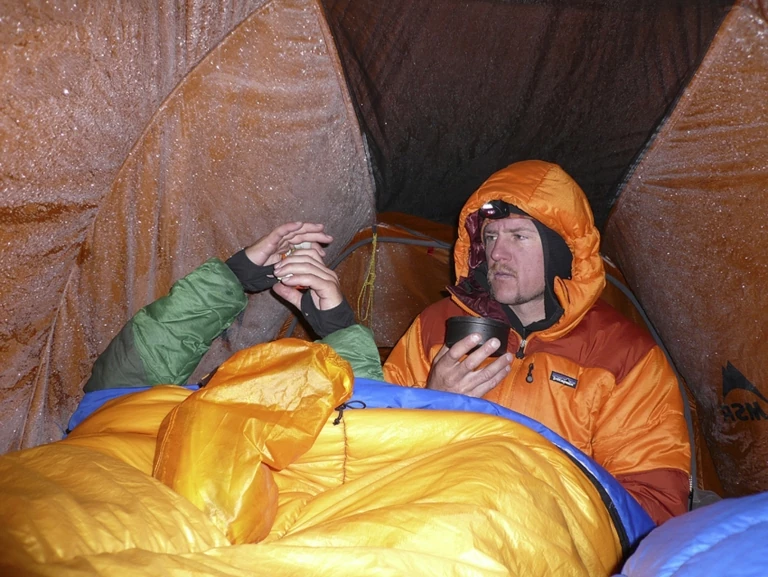
Even for seasoned professionals, endurance races like the Breck Epic or Breckenridge 100 are a brutal challenge of mental fortitude—similar, Vince says, to mountaineering. “You need a willingness to endure discomfort or things that aren’t fun for the hopeful chance at success.” Vince and Steve House suffer hopefully on a cornice deep in Pakistan’s Karakoram Range. Photo: Marko Prezelj
After the years of high-end alpine climbing, did the bike give you a break mentally?
Yeah, in a few ways. I’ve enjoyed the opportunities and successes that climbing has afforded me, though I’m not a person who really loves a lot of attention for accomplishments people perceive as remarkable; I’m just a regular person, with good and bad qualities like everyone else. But in climbing, some people I’d meet would think something of me, and it put me in an awkward position.
When I started biking, it was cool. I was in this community that didn’t know me at all; I was just kind of a crappy biker, scratching my way through the ranks. Though I did win some races, I was in the single-speed category—not the big leagues or anything. It was cool to be in a totally different-yet-similar-minded group of athletes.
I still had my foot in the climbing industry working as a Patagonia ambassador, a guide and a guide instructor. I didn’t realize it at the time, but looking back now, I needed a break [from climbing]. I’d gotten to a point with alpine climbing where there were times I was frightened. It required more luck. I had one kid at that time, and the risk involved in high-altitude expedition climbing was wearing away at my desire to keep doing it. But I also didn’t want to go halfway. I didn’t want to do easier climbs.
Biking also got me back to Colorado’s mountains and the beauty close to home. I’d forgotten about the aspens; climbers don’t really get to see aspens. I got to reconnect with things in Colorado that I’d forgotten about, or that I had taken for granted growing up there.
In climbing, you’re known to be a proponent of going light and fast and keeping it simple. Do you think single-speeding is an extension of that philosophy?
I do like simplicity and going with the simplest means to achieve an end, particularly in alpine climbing. There’s just an aesthetic that appeals to me. When I first tried single-speeding, I was attracted to its simplicity and spirit: You find the one gear for the day that offers the best compromise, and that’s what you go with.
Maybe some would consider me a Luddite, but I don’t feel like I am.
What about injuries? Which sport is more dangerous?
When you fall biking, you’re going to hit the ground. If you fall climbing, you’re usually just going to hit the end of the rope. But if things go wrong [in climbing], they go really wrong.
Mark Twight is a friend of mine and he knew I was getting into biking. So, I called him one day and said, “Mark, it finally happened …”
“What? You broke your collarbone.”
“No, I shaved my legs.”
That was a joke, but I did break my collarbone in another crash. I remember calling my wife: “Hey, I’ve got some bad news,” I said. “I’m on my way to the hospital.” She just shook her head. I also broke my radius in a race a few years back, and once before that while just riding.
In 2002, I ended up in the ER twice while climbing. I took a 140-foot fall and got stopped by a 13-centimeter ice screw. I hit my back on the way down, but it turned out it was just a bruised tailbone and I was OK. A month later, I was warming up on a mixed climb and some ice broke, swinging me hard into the wall and breaking my talus. I had the same nurses and doctors at the ER, and they looked at me like, “Oh my God, you again! Who is this sketchy guy?”
Why do you think there is so much literature on climbing/mountaineering and very little on mountain biking?
The depth of history is quite different. Climbing has these legendary mountains, like Mount Everest, the Matterhorn and the Eiger, that people have been seeking for centuries. What does mountain biking have that’s like the Eiger? You can go ride the most difficult trail around, and while you may not stick it like a pro and you may walk parts of it, you can still get to the end. Mountain biking is more like skiing: it’s Type I fun, where you’re deriving the pleasure while you’re on the bike.
There has been a lot of death or near-death involved in climbing over its history, and for whatever reason people want to read about that. In mountain biking, you’re describing the actual experience; that appeals to people in a different way.
Think about the hardest trail you’ve ridden. Was there a good story? We don’t really have a record of the first person who cleaned a trail. We know who did the first 14a or 15d. Climbing has a measurable, quantifiable difficulty: the summit or new route, the near-death experience. There’s more of a story to tell someone else, whereas in biking you just want to go ride.
Road cycling is a bit different. It’s older and has a lot more history, and there are these legendary races and rivalries. It’s also a lot more physically grueling. Endurance events like the Colorado Trail Race or Tour Divide may have more of that sort of interest, because they make for epic tales. Single-day outings on the cool trails here in Fruita, Grand Junction and Moab don’t have the story in and of themselves, but there are great images that make you want to be there.
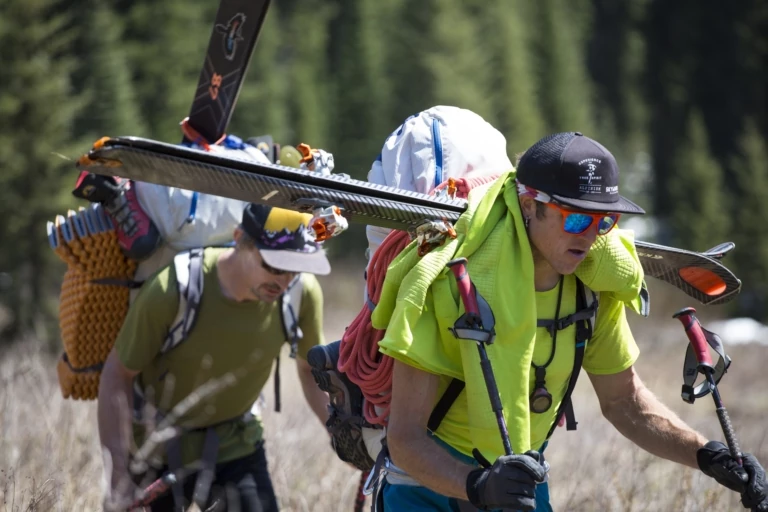
Depending on the objective, high-end mountaineering can demand a mixed skillset; Vince may be skiing, climbing, scrambling or simply hiking long miles with a heavy pack. Vince and Steve House’s mission to climb and ski Hall Peak in British Columbia’s Purcell Wilderness Conservancy, near the controversial Jumbo Glacier Resort, employed all of the above. Photo: Christian Pondella
In alpine climbing, there is an emphasis on partnership. Do you miss that in cycling?
That’s the one thing about alpine climbing that sets it apart from most other types of climbing. It’s not really just about you and the grade you can climb; you need a partner whose weaknesses and strengths you accept. They become part of you, and that really appealed to me. That’s part of the beauty. Along with my wife and family, my relationship with Steve [House] is a bond beyond anything else. You don’t have that in biking or bike racing, and I miss that.
The other side is that as a parent with limited time, bike racing allowed me to pursue something I enjoyed in a more limited time frame and without relying on a partner. With climbing, you’re going to be out there all day, trading off.
When you’re riding and trying to piece together a section of trail, is it similar to looking up at a crux pitch?
It is like projecting, and the process of connecting the difficult points is somewhat similar: “What angle do I want to hit this rock?,” or, “Where do I want my pedal stroke to be?” On a climb, you can stop midway and check holds or whatever. On a difficult section of trail, you have to fully commit every time you ride it, even on something you’re not 100 percent sure you can clean. You also need to have an exit strategy that isn’t required in climbing: “Am I going to unclip and dab, or jump off the bike?”
Ice climbing is different. You don’t project an ice pillar. Everything is 5.10x or easier, so it’s not that hard. It’s just really dangerous.
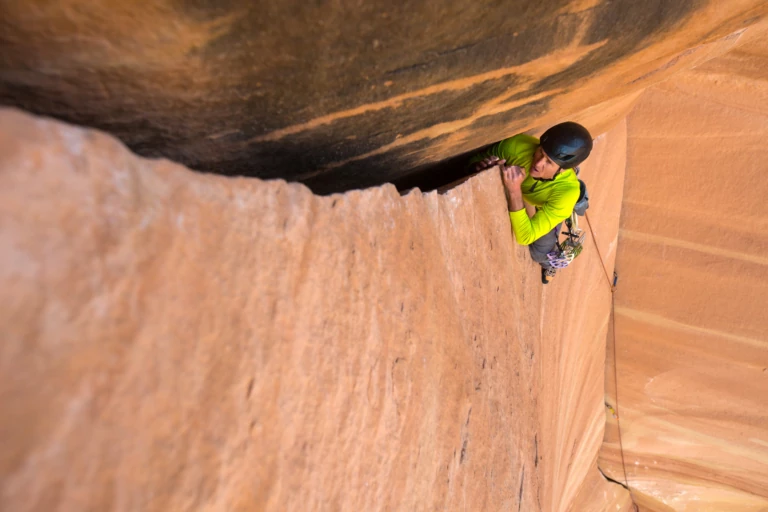
Nothing but good, clean rock. Vince may be famous for big summits and brutal rides, but sometimes the classic climbs—like the 5.11-rated Jupiter Crack in Indian Creek, Utah—are best for the soul. Photo: Andrew Burr
On our local trails, you’ll see where someone has made a bypass around a difficult section, or removed a tree or rock to make it easier. Do you see similar events occurring in climbing?
It’s easy to become the “new expert” and I think that’s unfortunate. Being able to ride those difficult sections just means you have to serve the proper apprenticeship to gain the skills requisite to do it. When you do, it is all the more rewarding.
This attempt to bring the mountain down to your level happens all the time in mountaineering. Everest is a good example. Its commercialization has essentially defamed it from being a premier mountaineering objective. They’ve removed trees and rocks, but in the form of oxygen—now there are new tanks with double the oxygen-flow rate. Guides don’t want anyone to get lost, so they put up a line for the entirety of the route and follow them from camp to camp. That makes it more attainable.
I can see how some people could see my viewpoint as elitist, but I think getting to the summits of these mountains and riding these more difficult trails is not a right. It’s a privilege. I don’t feel I’m entitled to make it up Cerro Torre now that the bolt ladder is gone; if I want to [climb it], I’m going to have to learn how.
You don’t have to go up Everest or Cerro Torre; there are other mountains you can climb instead. You don’t have to go ride Holy Cross; you can go ride something easier.
It’s essentially aesthetics, and that’s what makes life unique to me. These are the games we are playing and there are way bigger fish to fry in terms of humanity and what’s right and wrong. These are first world problems.
It’s worth having conversations about what’s good and bad in terms of style and taste, while not being needlessly unfair to others. With that though, I think we also shouldn’t change things unnecessarily from their natural state.
How do you sum up the difference between biking and climbing cultures?
Both communities think the other is more dangerous.
With mountain bikes, being super tech savvy with bike tuning can make or break the experience. Listen to podcasts or read articles on bike websites, and everyone wants to know what so-and-so’s suspension settings are, or what tires they use. Climbing is less involved in the tech. We don’t usually ask what cam was used or which quickdraws Adam Ondra clipped on Silence.
Ice climbing is a little different. It attracts gear nerds, and I mean that lovingly. That’s maybe more similar to the biking folks.
One other major difference: If you go to hang out with a high-end climbing subgroup, they’re going to be eating a lot of salad and drinking kombucha. You want to hang out with the mountain bikers. They’re drinking beer and eating pizzas.
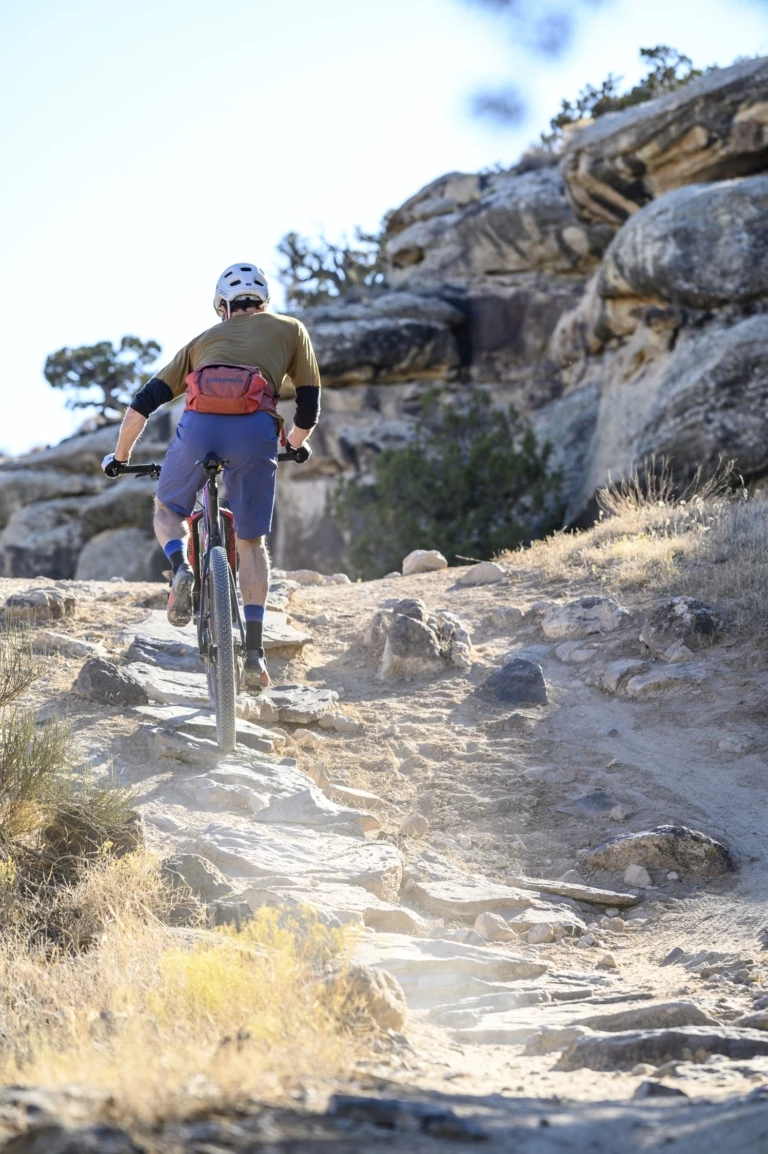
Boots, shoes or tires—when it comes to climbing, Vince Anderson has many modes to get to the top. It’s a useful skill when riding the notoriously rocky trails near his home in Grand Junction, Colorado. Photo: Jesse Selwyn
What’s your future hold on the bike and in climbing?
I’m trying to have a rock renaissance and part of that is because of my kids. For a while they were big into bikes and BMX racing, where I didn’t know anything and had to learn it.
But when they got into climbing, I was like, “Whoa, I can tell you about that! If you want to go out right now, let’s do it!” That’s been easier for me, and it’s helped me find a love of cragging and a desire to get better at it for my own sake. It’s gotten me back into climbing in general.
I did a climb this summer in Peru on Jirishanca with Josh Wharton. We made it really, really close to the summit. That was exhilarating, and I loved being there and would love the opportunity to try again and crack the code. There are some harder routes in the desert and the Black Canyon that I’d like to do. I would like to do some more alpine climbs that Josh calls “dad friendly.”
We’ll see about the bike. It’s hard to both ride and climb at a high level, and I’m an all-or-nothing person. When I crossed the line at the Breck Epic last year [he won it], I knew it was my last race for a while. I’m back to riding for fun, for cardio. I needed a break. But never say never.
